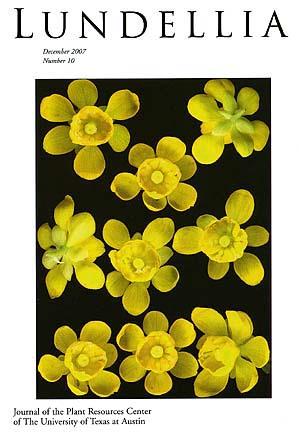The taxonomic history and geographical distribution of Heliotropium torreyi is reviewed. From amongst its fabric a new taxon was discerned and described as H. powelliorum. While allopatric with H. torreyi, the two taxa do not intergrade, suggesting that specific status is warranted. An illustration of the novelty is provided, along with a map showing its distribution, and that of its closest relative, H. torreyi.
Johnston (1959) was the first to note Heliotropium angustifolium Torr. (1858) to be a homonym of the earlier (1833) H. angustifolium Raf. As a substitute name he proposed H. torreyi I. M. Johnst., this lectotypified by a Charles Wright collection (Wright 1546) garnered in 1851 from the stony prairies of Zoquete [Sycamore] Creek, the boundary between present day Kinney and Val Verde counties, Texas.
Heliotropium torreyi is a perennial shrublet to 60 cm high having yellow or yellowish corollas. It is locally common in northeastern Mexico and closely adjacent United States. So far as known it is confined to the state of Texas in the U.S.A. and to the states of Chihuahua, Coahuila, Nuevo León, Tamaulipas, San Luis Potosí, and Querétaro in Mexico (Fig. 1). The purpose of the present paper is to document its distribution by dot maps, these based upon specimens on file at LL, SRSC, and TEX
While engaged in the present study, it soon became apparent that an undetected taxon lurked along the northwestern flank of Heliotropium torreyi, this previously swept unnoticed into the fabric of the latter by all workers. The taxon concerned is described as a new species, as follows:
Heliotropium powelliorum B. L. Turner,
sp. nov. (Fig. 2, 3)
Heliotropio torreyi I.M. Johnston similis sed differt spicis longioribus laxioribus, floribus ad angulos fere 90°patentibus, corollis minoribus, et nuculis aequaliter appressi-pubescentibus (vs. hispidulis trichomatibus erectis vel ascendentibus mixtis).
Type: UNITED STATES. TEXAS: Brewster Co: 4 mi S [of Terlingua?] along Terlingua-Lajitas highway, frequent on limestone soils, 3500 ft, 28 Sep 1947, Barton H. Warnock 7576 (Holotype: LL; Isotypes: MEXU, SMU, SRSC, TEX).
Intricately branched suffruticose Shrublets to 60 cm high. Stems with adpressed minutely muriculate white hairs 0.5–0.8 mm long. Leaves linear, equally pubescent on both surfaces like the stems, mostly 10–25 mm long, 0.5–1.5(2.0) mm wide; petioles 1.0–2.5 mm long. Inflorescence an arcuate slender elongate spike 5–12 cm long; peduncles 0.5–2.0 cm long. Flowers arranged loosely along the stem (the nodes mostly 5–10 mm apart) and spreading at nearly right angles on pedicels 0.5–2.0 mm long. Calyces 1.9–3.0 mm long; lobes lanceolate, separate to the base, pubescent like the stems. Corollas yellow or yellowish, 5-lobed, the lobes lanceolate, mostly 1.5–2.5 mm long, the tubes 2–3 mm long. Fruits of 1–4 orbicular nutlets ca. 1 mm across, evenly pubescent with markedly adpressed hairs, not at all ascending or spreading as in its congener, H. torreyi.
Representative Specimens Examined: MEXICO: CHIHUAHUA. Mpio. Aldama: 19 km N of Aldama on the road to Coyame, 1300 m, 9 Jul 1972, Chiang et al. 8362 (LL). Mpio. Coyame: 6 mi W of Ojinaga, 1000 m, 2 Oct 1972, Chiang et al. 9741 (LL). Mpio. Julimes: Sierra del Roque, N of Julimes, 1450–2150 m, 24 Aug 1973, Johnston et al. 12325 (LL). UNITED STATES. TEXAS: Brewster Co.: Solitario, 1984–1985, Clarke 195, 196, 392, 393, 495, 496, 1051, 1074 (all SRSC); ca. 3 mi W of Terlingua, 24 Sep 1966, Correll 33881 (LL); limestone ridge between Terlingua and Lajitas, 11 Sep 1961, Correll & Johnston 24468 (LL); ca. 2 mi W of Terlingua, 3060 ft, 25 Jul 1973, Henrickson 11242 (TEX); 3–5 mi W of Shafter, 14 Jul 1944, Hinckley 3108 (SRSC); between Terlingua and Lajitas, on hillside, 14 Sep 1947, Lundell 14766 (LL); near head of Reed Plateau, 27 Jun 1978, Powell 3335 (SRSC, TEX); N end of Reed Plateau, in the highway gap, 4 Jul 1979, Powell 3455 (SRSC, TEX); abundant on Mesa de Anguila near St. Helena Canyon, 14 Jul 1937, Warnock 21126 (LL, SRSC). Presidio Co.: Righthand Shutup, Solitario, Big Bend Ranch, 7 Jun 1975, Butterwick & Strong 856 (TEX); low talus slopes E of Solitario Peak within the Solitario, Big Bend Ranch, 25 Sep 1975, Butterwick & Lamb 1649 (TEX); Solitario, 11 Nov 1994, Hardy 738 (SRSC); 5 mi S of Shafter, 5 Aug 1945, Lundell & Lundell 14280 (LL, SMU); 3 mi SW of Shafter, 30 Jul 1945, Muller 8649 (LL, SMU); Solitario, 30 Jun 1984, Powell & Powell 4383 (SRSC); hills near Shafter, 28 Apr 1985, Powell & Powell 5072 (SRSC); 4 mi S of Shafter, 13 Mar 2005, Terry & Turner 25–20 (SRSC); along highway between Redford and Lajitas, 10 Aug 1962, Warnock 18813 (SRSC); Solitario, 30 Jul 1957, Warnock & Muller 15717 (SRSC); Reed Plateau, near Villa de la Mina, 22 Nov 2004, Weckesser 513 (SRSC); Reed Plateau, Coultrin's Canyon, 23 Jun 2005, Weckesser 556 (SRSC); Reed Plateau, N of Villa de la Mina, 3315 ft, 21 Aug 2006, Weckesser 980 (SRSC).
Heliotropium powelliorum differs from H. torreyi in having much longer, more loosely arranged, flowering spikes, the flowers smaller and borne at nearly right angles to its axis, this contrasting with those found in H. torreyi. In addition, the leaves are mostly longer, and have a more uniformly disposed pubescence, and the fruiting bodies are markedly evenly adpressed-pubescent, unlike those of H. torreyi, the latter having a heterogeneous array of ascending to erect hairs. I have not been able to detect intergrades between the two taxa among the numerous specimens examined, hence my treatment of these two allopatric entities as good biological species.
I take considerable pleasure in naming this heretofore cryptic species for my academic son, A. Michael Powell (Ph.D., 1963, University of Texas, Austin) Emeritus Professor of Biology and Director of the SRSC Herbarium, Sul Ross State University, Alpine, and his accomplished wife of many years, Shirley. Both are authors of books having to do with the flora of Texas, and deserving of the honor extended.








